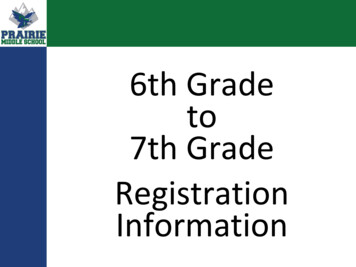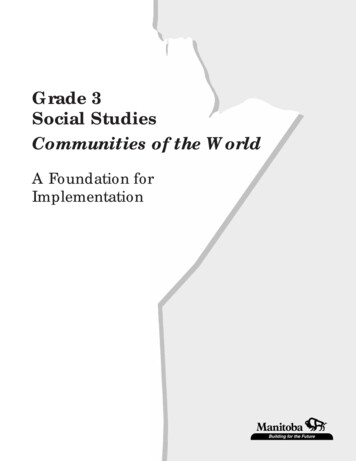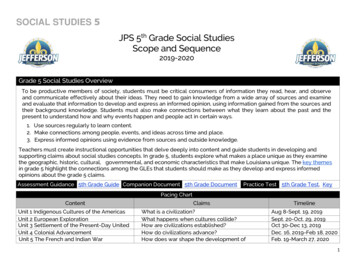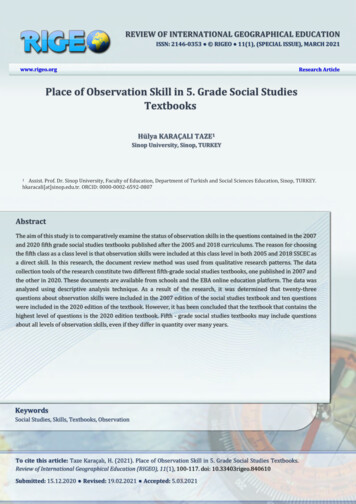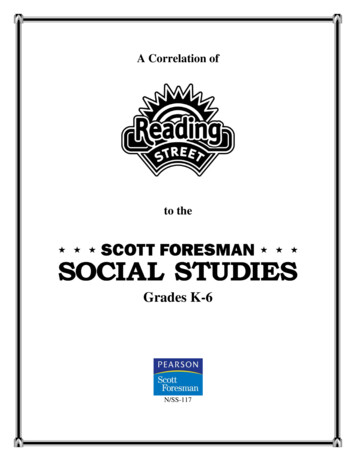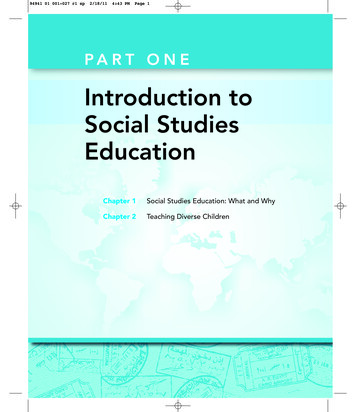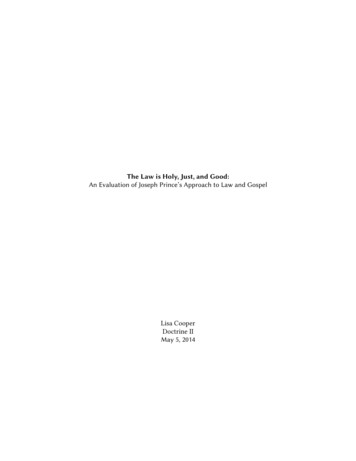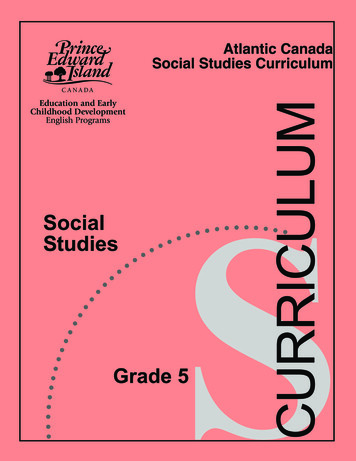
Transcription
2012Prince Edward IslandDepartment of Education andEarly Childhood Development250 Water Street, Suite 101Summerside, Prince Edward IslandCanada, C1N 1B6Tel: (902) 438-4130Fax: (902) 438-4062www.gov.pe.ca/eecd/
ACKNOWLEDGMENTSAcknowledgmentsThe Prince Edward Island Department of Education and Early Childhood Development acknowledgesthe work of the social studies consultants and other educators who served on the regional social studiescommittee.New BrunswickJohn HildebrandBarbara HillmanNewfoundland and LabradorDarryl FillierNova ScotiaMary FedorchukBruce FisherRick McDonaldJennifer BurkePrince Edward IslandBethany DoironLaura Ann NoyeThe Prince Edward Island Department of Education and Early Childhood Development also acknowledgesthe contribution of all the educators who served on provincial writing teams and curriculum committees, andwho reviewed or piloted the curriculum.The Prince Edward Island Department of Education and Early Childhood Development recognizes thecontribution made by Tammy MacDonald, Consultation/Negotiation Coordinator, Historical Researcherfor the Mi’kmaq Confederacy of Prince Edward Island, for her contribution to the development of thiscurriculum.ATLANTIC CANADA SOCIAL STUDIES CURRICULUM GUIDE: GRADE 5i
CONTENTSiiATLANTIC CANADA SOCIAL STUDIES CURRICULUM GUIDE: GRADE 5
CONTENTSContentsIntroductionBackground . 1Aims of Social Studies . 1Purpose of Curriculum Guide . 2Guiding Principles. 2Program Designand OutcomesOverview . 3Essential Graduation Learnings (EGLs) . 4General Curriculum Outcomes (GCOs) . 5Processes. 6Attitudes, Values, and Perspectives. 7Contexts for Learningand TeachingThe Learner. 9Equity and Diversity . 10Principles Underlying the Social Studies Curriculum. 10The Social Studies Learning Environment . 11Inquiry.20Inquiry Approach to Organizing Thinking Concepts and Skills . 20Assessment and Evaluation of Student Learning . 24Curriculum OverviewKindergarten Grade 9 Social Studies Program . 29Grade 4: Explorations. 30Grade 5: Investigating Past Societies . 31Grade 6: PEI History . 32Grade 6: World Cultures . 33How to Use the Four-Column Curriculum Layout . 35Grade 5 CurriculumGrade 5: Year Overview . 39Teacher Notes. 40Unit 1: Introduction . 41Unit 2: Environment . 51Unit 3: Social Structure . 61Unit 4: Decision Making. 69Unit 5: Interactions . 81Unit 6: My Society . 89AppendicesAppendix A: Concepts in Kindergarten 9 Social Studies . 99Appendix B: Process-Skills Matrix . 103Appendix C: Terminology and Cooperative Learning Structures . 111Appendix D: Societies.115Appendix E: Beothuk Encampments . 119Appendix F: Inquiry Approach to Organizing Thinking Conceptsand Skills. 123Appendix G: Using Primary Sources in the Classroom . 129Appendix H: Student Response Journals . 135Appendix I: Portfolio Assessment . 139Appendix J: Rubrics in Assessment . 143Appendix K: Geographic and Mapping Skills . 147Appendix K-1: Geographic and Mapping Skills Record Chart. 156ATLANTIC CANADA SOCIAL STUDIES CURRICULUM GUIDE: GRADE 5iii
ivATLANTIC CANADA SOCIAL STUDIES CURRICULUM GUIDE: GRADE 5
INTRODUCTIONIntroductionBackgroundThe Atlantic Canada social studies curriculum was planned anddeveloped by regional committees whose deliberations were guidedby consideration of the learners and input from teachers. The regionalcommittees consisted of teachers, other educators, and consultantswith a diverse range of experiences and backgrounds in education.Each curriculum level was strongly influenced by current social studiesresearch and developmentally appropriate pedagogy.Aims ofSocial StudiesThe vision for the Atlantic Canada social studies curriculum is toenable and encourage students to examine issues, respond critically andcreatively, and make informed decisions as individuals and as citizens ofCanada and of an increasingly interdependent world.An effective social studies curriculum prepares students to achieve allessential graduation learnings. In particular, social studies, more thanany other curriculum area, is vital in developing citizenship. Socialstudies embodies the main principles of democracy, such as freedom,equality, human dignity, justice, rule of law, and civic rights andresponsibilities.The social studies curriculum provides opportunities for students toexplore multiple approaches that may be used to analyse and interprettheir own world and the world of others. Social studies presents uniqueand particular ways for students to view the interrelationships amongEarth, its people, and its systems. The knowledge, skills, and attitudesdeveloped through the social studies curriculum empower studentsto be informed, responsible citizens of Canada and the world, and toparticipate in the democratic process to improve society.In particular, the social studies curriculum: integrates the concepts, processes, and ways of thinking drawnfrom the diverse disciplines of the social sciences includinghistory, geography, economics, political science, sociology, andanthropology—it also draws from the humanities, literature, andthe pure sciences provides the multidisciplinary lens through which students examineissues affecting their lives from personal, provincial, national,academic, pluralistic, and global perspectives.ATLANTIC CANADA SOCIAL STUDIES CURRICULUM GUIDE: GRADE 51
INTRODUCTIONPurpose ofCurriculum GuideThe overall purpose of this curriculum guide is to advance social studieseducation and social studies teaching and learning, and at the sametime, recognize and validate effective practices that already exist inmany classrooms.More specifically, this curriculum guide: provides detailed curriculum outcomes to which educators andothers can refer when making decisions concerning learning;experiences, instructional techniques, and assessment strategies inthe grade 5 social studies program; informs both educators and members of the general public aboutthe philosophy and scope of social studies education for the middleschool level in the Atlantic provinces; promotes the effective learning and teaching of social studies forstudents enrolled in grade 5 classroomsGuiding Principles2All kindergarten to grade 9 curriculum and resources should reflect theprinciples, rationale, philosophy, and content of the Foundation for theAtlantic Canada Social Studies Curriculum (1999) by: being meaningful, significant, challenging, active, integrative, andissues based; being consistent with current research pertaining to how childrenlearn; incorporating multiple perspectives; promoting the achievement of Essential Graduation Learnings(EGLs), General Curriculum Outcomes (GCOs), and Key-StageCurriculum Outcomes (KSCOs); reflecting a balance of local, national, and global content; promoting achievement in the processes of communication,inquiry, and participation; promoting literacy through the social studies; developing knowledge, skills, and attitudes for lifelong learning; promoting the development of informed and active citizens; contributing to the achievement of equity and supporting diversity; supporting the realization of an effective learning environment; promoting opportunities for cross-curricular connections; promoting resource-based learning; promoting the integration of technology in learning and teachingsocial studies; promoting the use of diverse learning and assessment strategies.ATLANTIC CANADA SOCIAL STUDIES CURRICULUM GUIDE: GRADE 5
PROGRAM DESIGN AND OUTCOMESProgram Design and OutcomesThis social studies curriculum is based on Foundation for the AtlanticCanada Social Studies Curriculum (1999). Specific CurriculumOutcomes (SCOs) were developed to be congruent with Key-StageCurriculum Outcomes (KSCOs), General Curriculum Outcomes(GCOs), and Essential Graduation Learnings (EGLs). In addition,the processes of social studies, as well as the attitudes, values, andperspectives, are embedded in the SCOs.OverviewEssential GraduationLearningsProcesses communication inquiry participationCitizenship,Power, andGovernanceCultureandDiversityGeneral esPeople,Place, andEnvironmentTime,Continuity,and ChangeKey-Stage Curriculum OutcomesSpecific Curriculum OutcomesATLANTIC CANADA SOCIAL STUDIES CURRICULUM GUIDE: GRADE 53
PROGRAM DESIGN AND OUTCOMESEssentialGraduationLearningsEducators from the Atlantic provinces worked together to identifyabilities and areas of knowledge considered essential for studentsgraduating from high school. These are referred to as EssentialGraduation Learnings. Some examples of Key-Stage Outcomes in socialstudies that help students move towards attainment of the EssentialGraduation Learnings are given below.Aesthetic ExpressionGraduates will be able to respond with critical awareness to variousforms of the arts and be able to express themselves through the arts.By the end of grade 6, students will be expected to: describe how perspectives influence the ways experiences areinterpreted.CitizenshipGraduates will be able to assess social, cultural, economic, andenvironmental interdependence in a local and global context.By the end of grade 6, students will be expected to: describe the purpose, function, powers, and decision-makingprocesses of Canadian governments.CommunicationGraduates will be able to use the listening, viewing, speaking, reading,and writing modes of language(s), as well as mathematical and scientificconcepts and symbols, to think, learn, and communicate effectively.By the end of grade 6, students will be expected to: use maps, globes, pictures, models, and technologies to representand describe physical and human systems.Personal DevelopmentGraduates will be able to continue to learn and to pursue an active,healthy lifestyle.By the end of grade 6, students will be expected to: identify trends that may shape the futureProblem SolvingGraduates will be able to use the strategies and processes needed tosolve a wide variety of problems, including those requiring language,mathematical, and scientific concepts.By the end of grade 6, students will be expected to: identify and compare events of the past to the present in order tomake informed, creative decisions about issues.4ATLANTIC CANADA SOCIAL STUDIES CURRICULUM GUIDE: GRADE 5
PROGRAM DESIGN AND OUTCOMESTechnologicalCompetenceGraduates will be able to use a variety of technologies; demonstratean understanding of technological applications; and apply appropriatetechnologies for solving problems.By the end of grade 6, students will be expected to: identify and describe examples of positive and negative interactionsamong people, technology, and the environment.General CurriculumOutcomes(Conceptual Strands)The general curriculum outcomes (GCOs) for the social studiescurriculum are organized around six conceptual strands. These generalcurriculum outcomes statements identify what students are expectedto know and be able to do upon completion of study in social studies.Specific social studies concepts are found within the conceptual strands(see Appendix A). Examples of key-stage curriculum outcomes by theend of grade 6 are given for each general curriculum outcome.Citizenship, Power, andGovernanceStudents will be expected to demonstrate an understanding of therights and responsibilities of citizenship, and the origins, functions, andsources of power, authority, and governance.By the end of grade 6, students will be expected to: identify and explain the rights and responsibilities of individualcitizens in a local, national, and global context; recognize how and why individuals and groups have differentperspectives on public issues.Culture and DiversityStudents will be expected to demonstrate an understanding of culture,diversity, and worldview, while recognizing the similarities anddifferences reflected in various personal, cultural, racial, and ethnicperspectives.By the end of grade 6, students will be expected to: explain why cultures meet human needs and wants in diverse ways; describe how perspectives influence the ways in which experiencesare interpreted.Individuals, Societies, andEconomic DecisionsStudents will be expected to demonstrate the ability to make responsibleeconomic decisions as individuals and as members of society.By the end of grade 6, students will be expected to: give examples of various institutions that make up economicsystems; explain how a government’s policies affect the living standards of allits citizens.ATLANTIC CANADA SOCIAL STUDIES CURRICULUM GUIDE: GRADE 55
PROGRAM DESIGN AND OUTCOMESInterdependenceStudents will be expected to demonstrate an understanding of theinterdependent relationships among individuals, societies, and theenvironment—locally, nationally, and globally—and the implicationsfor a sustainable future.By the end of grade 6, students will be expected to: recognize and explain the interdependent nature of relationshipsamong individuals, societies, and the environment.People, Place, andEnvironmentStudents will be expected to demonstrate an understanding of theinteractions among people, places, and the environment.By the end of grade 6, students will be expected to: use maps, globes, pictures, models, and technology to represent anddescribe physical and human systems; describe examples of cause and effect and change over time.Time, Continuity, andChangeStudents will be expected to demonstrate an understanding of the pastand how it affects the present and the future.By the end of grade 6, students will be expected to: identify trends that may shape the future; research and describe historical events and ideas from differentperspectives.ProcessesThe social studies curriculum consists of three major processes:communication, inquiry, and participation. (See Appendix B - ProcessSkills Matrix.) These processes are reflected in the “Strategies forLearning and Teaching” and “Tasks for Instruction and/or Assessment”found in social studies curriculum guides. These processes incorporatemany skills—some of which are responsibilities shared acrosscurriculum areas, whereas others are critical to social studies.CommunicationCommunication requires that students listen, read, interpret, translate,express ideas, and share information.InquiryInquiry requires that students formulate and clarify questions,investigate problems, analyse relevant information, and develop rationalconclusions supported by evidence.ParticipationParticipation requires that students act both independently andcollaboratively in order to solve problems, make decisions, andnegotiate and enact plans for action in ways that respect and value thecustoms, beliefs, and practices of others.6ATLANTIC CANADA SOCIAL STUDIES CURRICULUM GUIDE: GRADE 5
PROGRAM DESIGN AND OUTCOMESAttitudes, Values,and PerspectivesListed below are major attitudes, values, and perspectives in grade 4 - 6social studies that have been organized according to the six conceptualstrands and the three processes of the foundation document. Someattitudes, values, and perspectives are embedded in more than onestrand or process—consistent with the integrative nature of socialstudies.By Conceptual StrandCitizenship, Power, and Governance appreciate the varying perspectives on the effects of power,privilege, and authority on Canadian citizensdevelop attitudes that balance rights with responsibilitiesvalue decision making that results in positive changeCulture and Diversity recognize and respond in appropriate ways to stereotyping/discriminationappreciate that there are different worldviewsappreciate the different approaches of cultures to meeting needsand wantsIndividuals, Societies, and Economic Decisions appreciate the wide range of economic decisions that individualsmake and their effectsrecognize the varying impacts of economic decisions on individualsand groupsrecognize the role that economics plays in empowerment anddisempowermentInterdependence appreciate and value the struggle to attain universal human rightsrecognize the varying perspectives on the interdependence ofsociety, the economy, and the environmentappreciate the impact of technological change on individuals andsocietyPeople, Place, and the Environment appreciate the varying perspectives of regionsvalue maps, globes, and other geographic representations asvaluable sources of information and tools for learningappreciate the relationships between attributes of place and culturalvaluesATLANTIC CANADA SOCIAL STUDIES CURRICULUM GUIDE: GRADE 57
PROGRAM DESIGN AND OUTCOMESTime, Continuity, and Change By Processvalue society’s heritageappreciate that there are varying perspectives on a historical issuerecognize the contribution of the past to present-day societyCommunication read criticallyrespect other points of viewuse various forms of group and interpersonal communicationInquiry recognize that there are various perspectives in the area of inquiryrecognize bias in others and in themselvesappreciate the value of critical and creative thinkingParticipation 8take responsibility for individual and group workrespond to class, school, community, or national public issuesvalue the importance of taking action to support active citizenshipATLANTIC CANADA SOCIAL STUDIES CURRICULUM GUIDE: GRADE 5
CONTEXTS FOR LEARNING AND TEACHINGContexts for Learning and TeachingThe LearnerThe grade 5 student is in transition from childhood to adolescence.This grade 5 year begins to bridge the gap between the foundationalyears and the years leading to maturity. The student showsimprovement in language skills, acquires study habits, employs theart of asking more in-depth questions and begins to develop morecognitive reasoning. Since educators have an important role in helpingyoung people prepare for the next stage in their development, they needto know and appreciate characteristics of students at this stage and theirapplication to learning.AestheticEach child has an aesthetic dimension. Children are exposed to artisticprocesses and products in a variety of genres and cultures. They areprovided opportunities to create, perceive, and communicate throughthe arts. Critical and analytical thinking and problem-solving skillsare developed and applied in practical learning experiences. Anappreciation for and experience in those things that constitute thearts add to children’s understanding of the world, their culture, andtheir community. Children with an aesthetic sensibility value culture,environment, and personal surroundings.Emotional DevelopmentEach child has an emotional dimension. Children learn best in a safe,supportive environment. Positive feelings toward self, others, andlearning are continuously promoted by the school. As children movefrom kindergarten through grade 6, they are encouraged to becomeindependent and more responsible for their own learning. There is arelationship between success and self-esteem. Learning is structured sothat every child experiences success. Children are encouraged to becomemore reflective and introspective. They are given opportunities toconsider ideas that are of both general and personal significance.Intellectual DevelopmentMany students are still in a concrete stage of thinking. Some are ableto handle more abstract concepts and to apply simple problemsolving techniques. This group lives more in the present. These youngpeople need opportunities to develop their formal thinking skills andstrategies if they are to move from concrete to abstract thinking. Todevelop the skills of critical analysis and decision making, these youngpeople should be given the opportunity to apply skills to solve real-lifeproblems.Physical DevelopmentOverall, physical growth during this year is much less rapid than inadolescence. Gross motor skills are improving and activities using largemuscles are easily accomplished. Fine motor skills are still developingand students enjoy activities using these skills. What is taught and howit is taught should reflect the range of needs and interests of students.ATLANTIC CANADA SOCIAL STUDIES CURRICULUM GUIDE: GRADE 59
CONTEXTS FOR LEARNING AND TEACHINGSocial DevelopmentAt this stage of development young people become more interestedin group involvement and sociability. They are often cautious andfear failure. They are hesitant to demonstrate affection. Parentalinvolvement in their lives is still crucial and should be encouraged.There is a need for many positive social interactions with peers andadults. These young people benefit from opportunities to work withpeers in collaborative and small-group learning activities. They requirestructure and clear limits, as well as opportunities to set standards forbehaviour and establish realistic goals. Young people in this age grouptend to collect items. What is collected may depend on the child’spersonal interest rather than availability of objects. They are alsointerested in arranging their collections. This can be of educationalvalue.Equity andDiversityThe Atlantic Canada social studies curriculum is designed to meetthe needs and interests of all students. The curriculum should providefor the inclusion of the interests, values, experiences, and languageof each student and of the many groups within our local, regional,national, and global communities.The society of Atlantic Canada, like all of Canada, reflects diversityin race, ethnicity, gender, ability, values, lifestyles, and languages.Schools should foster the understanding of such diversity. Social studiescurricula promotes a commitment to equity by valuing, appreciating,and accepting the diverse and multicultural nature of our society, aswell as by fostering awareness and critical analysis of individual andsystemic discrimination.In a school setting characterized by mutual trust, acceptance, andrespect, student diversity is both recognized and valued. All studentsare entitled to be respected and valued and, in turn, are responsiblefor respecting and valuing all other people. They are entitled toan educational system that affirms their gender, racial, ethnic, andcultural identity, and promotes the development of a positive selfimage. Educators should ensure that classroom practices and resourcespositively and accurately reflect diverse perspectives, and rejectprejudiced attitudes and discriminatory behaviours.PrinciplesUnderlying theSocial StudiesCurriculum10Empowering an effective social studies is meaningful, significant,challenging, active, integrative, and issues-based. Meaningful social studies encourages students to learn throughpurposeful experiences designed around stimulating ideas,social issues, and themes, and discourages the memorization ofdisconnected pieces of information. Significant social studies is student centred and age appropriate.Superficial coverage of topics is replaced by emphasis on the trulysignificant events, concepts, and principles that students need toknow and be able to apply in their lives. Challenging social studies involves teachers modelling highexpectations for their students and themselves, promoting athoughtful approach to inquiry, and demanding well-reasonedarguments.ATLANTIC CANADA SOCIAL STUDIES CURRICULUM GUIDE: GRADE 5
CONTEXTS FOR LEARNING AND TEACHING Active social studies encourages students to assume increasingresponsibility for managing their own learning. Exploration,investigation, critical and creative thinking, problem solving,discussion and debate, decision making, and reflection are essentialelements of this principle. This active process of constructingmeaning encourages lifelong learning.Integrative social studies crosses disciplinary borders to exploreissues and events, while using and reinforcing informational,technological, and application skills. This approach facilitatesthe study of the physical and cultural environment by makingappropriate and meaningful connections to the human disciplinesand to the concepts of time, space, continuity, and change.Issues-based social studies considers the ethical dimensionsof issues, and addresses controversial topics. It encouragesconsideration of opposing points of view, respect for well supportedpositions, sensitivity to cultural similarities and differences, and acommitment to social responsibility and action.The Social StudiesLearningEnvironmentThe Effective SocialStudies ClassroomWith the accelerating pace and scope of change, today’s studentscannot prepare for life by merely learning isolated facts. Problemsolving, critical and creative thinking, and informed decision makingare essential for success in the future. The social studies learningenvironment contributes significantly to the development of thesecritical attributes.An effective instructional environment incorporates principles andstrategies that recognize and accommodate varied learning styles,multiple intelligences, and abilities that students bring to the classroom.Teaching approaches and strategies foster a wide variety of experiencesto actively engage all students in the learning process. The nature andscope of social studies provide unique opportunities to do this.To meet these challenges, the social studies program reflects a widerange of elements.Respectful of diversityStudents come to the classroom from backgrounds that represent thereality of Canada’s diversity, whether it is in terms of social identity,economic context, race/ethnicity, or gender. The social studies learningenvironment attempts to affirm the positive aspects of this diversity andto foster an understanding and appreciation of the multiple perspectivesthat this diversity can lend to the classroom. Regardless of backgrounds,students should be given equal access to educational opportunities.ATLANTIC CANADA SOCIAL STUDIES CURRICULUM GUIDE: GRADE 511
CONTEXTS FOR LEARNING AND TEACHINGInclusive and invitingThe social studies classroom should be a psychologically safe place inwhich to learn. It should be free from bias and unfair practices arisingfrom perceptions related to ability, race, ethnicity, culture, gender, orsocioeconomic status. Students come with different attitudes, levelsof knowledge, and points of view. These differences should not beobstacles, but should offer opportunities for individuals to rise abovestereotypes and to develop positive self-images. Students should beprovided collaborative learning contexts through which they canbecome aware of and transcend their own stereotypical attitudes andbehaviours.Engaging and interactiveIf classrooms are to be places where there is respect for diversity andwhere learning is engaging and interactive, students will be expected toparticipate in inquiry and problem-solving situations. Students will beprovided with direct and vicarious experiences to which they can applysocial studies skills, strategies, and processes for purposeful ends. Ratherthan assume passive roles, students will bring their critical facultiesto information and knowledge to shape information into meaningfulpatterns.Relevant and significantThe grade 5 curriculum should provide learning situations thatincorporate student interests and encourage students to question theirknowledge, their assumptions, and their attitudes. In so doing, theywill come to understand and appreciate their own heritage and cultureat a deeper level. Past history and contemporary studies play a key rolesince they provide the building blocks of social studies. In addition, thestudents’ rational and critical involvement in learning about these playsan integral part in development of the person and citizen.Resource-Based LearningEffective social studies teaching and learning actively involves students,teachers, and teacher-librarians in the effective use of a wide range ofprint, non-print, and human resources. Resource-based learning fostersthe development of individual students by accommodatin
2 ATLANTIC CANADA SOCIAL STUDIES CURRICULUM GUIDE: GRADE 5 INTRODUCTION Purpose of Curriculum Guide Guiding Principles The overall purpose of this curriculum guide is to advance social studies education and social studies teaching and learning, and at the same time, recognize and validate e
